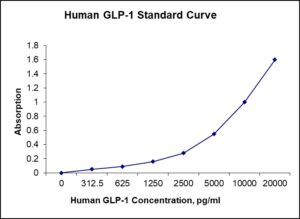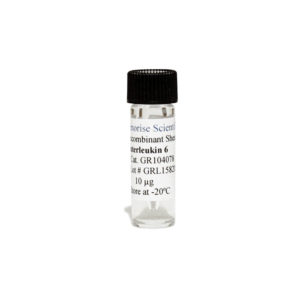Nori Human GLP-1 ELISA Kit
$461.00 – $832.00
This ELISA kit is for quantification of GLP-1 in human. This is a quick ELISA assay that reduces time to 50% compared to the conventional method, and the entire assay only takes 3 hours. This assay employs the quantitative sandwich enzyme immunoassay technique and uses biotin-streptavidin chemistry to improve the performance of the assays. An antibody specific for GLP-1 has been pre-coated onto a microplate. Standards and samples are pipetted into the wells and any GLP-1 present is bound by the immobilized antibody. After washing away any unbound substances, a detection antibody specific for GLP-1 is added to the wells. Following wash to remove any unbound antibody reagent, a detection reagent is added. After intensive wash a substrate solution is added to the wells and color develops in proportion to the amount of GLP-1 bound in the initial step. The color development is stopped, and the intensity of the color is measured.
Alternative names for GLP-1: Glucagon-like peptide-1
This product is for laboratory research use only, not for diagnostic and therapeutic purposes or any other purposes.
- Description
- How Elisa Works
- Product Citations
- Reviews (0)
Description
Nori Human GLP-1 ELISA Kit Summary
Alternative names for GLP-1: Glucagon-like peptide-1
| Assay Type | Solid Phase Sandwich ELISA |
| Format | 96-well Microplate or 96-Well Strip Microplate |
| Method of Detection | Colorimetric |
| Number of Targets Detected | 1 |
| Target Antigen Accession Number | NA |
| Assay Length | 3 hours |
| Quantitative/Semiquantitative | Quantitative |
| Sample Type | Plasma, Serum, Cell Culture, Urine, Cell/Tissue Lysates, Synovial Fluid, BAL, |
| Recommended Sample Dilution (Plasma/Serum) | No dilution for sample <ULOQ; sufficient dilution for samples >ULOQ |
| Sensitivity | 60 pg/mL |
| Detection Range | 0.31-20 ng/mL |
| Specificity | Human GLP-1 |
| Cross-Reactivity | < 0.5% cross-reactivity observed with available related molecules, < 50% cross-species reactivity observed with species tested. |
| Interference | No significant interference observed with available related molecules |
| Storage/Stability | 4 ºC for up to 6 months |
| Usage | For Laboratory Research Use Only. Not for diagnostic or therapeutic use. |
| Additional Notes | The kit allows for use in multiple experiments. |
Standard Curve
Kit Components
1. Pre-coated 96-well Microplate
2. Biotinylated Detection Antibody
3. Streptavidin-HRP Conjugate
4. Lyophilized Standards
5. TMB One-Step Substrate
6. Stop Solution
7. 20 x PBS
8. Assay Buffer
Other Materials Required but not Provided:
1. Microplate Reader capable of measuring absorption at 450 nm
2. Log-log graph paper or computer and software for ELISA data analysis
3. Precision pipettes (1-1000 µl)
4. Multi-channel pipettes (300 µl)
5. Distilled or deionized water
Protocol Outline
1. Prepare all reagents, samples and standards as instructed in the datasheet.
2. Add 100 µl of Standard or samples to each well and incubate 1 h at RT.
3. Add 100 µl of Working Detection Antibody to each well and incubate 1 h at RT.
4. Add 100 µl of Working Streptavidin-HRP to each well and incubate 20 min at RT.
5. Add 100 µl of Substrate to each well and incubate 5-30 min at RT.
6. Add 50 µl of Stop Solution to each well and read at 450 nm immediately.
Background:
Glucagon-like peptide-1 (GLP-1) is a 30 amino acid long peptide hormone deriving from the tissue-specific posttranslational processing of the proglucagon. It is produced and secreted by intestinal enteroendocrine L-cells and certain neurons within the nucleus of the solitary tract in the brainstem upon food consumption. GLP-1 decreases blood sugar levels in a glucose-dependent manner by enhancing the secretion of insulin. [1] “Glucagon-like peptide-1 decreases endogenous amyloid-beta peptide (Abeta) levels and protects hippocampal neurons from death induced by Abeta and iron. [2] As GLP-1 binds to GLP-1 receptors expressed on the pancreatic β cells, the receptors couples to G-protein subunits and activates adenylate cyclase that increases the production of cAMP from ATP. Subsequently, activation of secondary pathways, including PKA and Epac2, alters the ion channel activity causing elevated levels of cytosolic Ca2+ that enhances exocytosis of insulin-containing granules. GLP-1 secretion in patients with type 2 diabetes does not differ from healthy subjects.[3] Pancreatic proglucagon gene expression is promoted upon fasting and hypoglycaemia induction and inhibited by insulin. Conversely, intestinal proglucagon gene expression is reduced during fasting and stimulated upon food consumption. However, as a result of tissue-specific posttranslational processing mechanisms, different peptides are produced in the different cells.[4] Endogenous GLP-1 is rapidly degraded primarily by dipeptidyl peptidase-4 (DPP-4), but also neutral endopeptidase 24.11 and renal clearance, resulting in a half-life of approximately 2 minutes.
References
- Ma X, Guan Y, Hua X (2014) J Diabetes. 6 (5): 394–402.
- Perry, et al. (2003). Journal of Neuroscience Research. 72 (5): 603–612.
- Calanna S, et al. (2013). Diabetologia. 56 (5): 965–972.
- Baggio LL, Drucker DJ (2007). Gastroenterology. 132 (6): 2131–2157.
Be the first to review “Nori Human GLP-1 ELISA Kit”
You must be logged in to post a review.






























Reviews
There are no reviews yet.